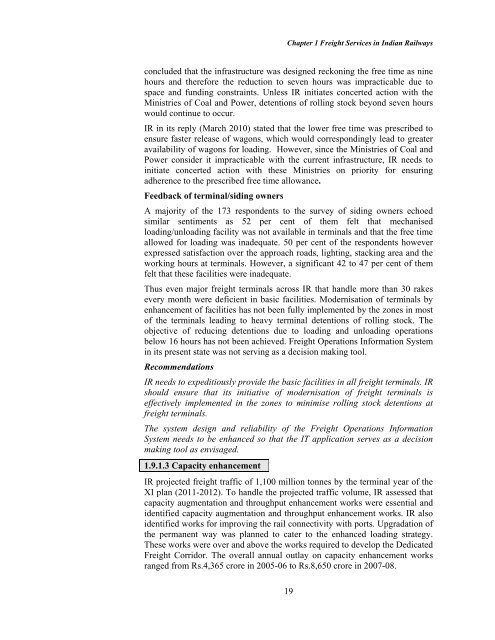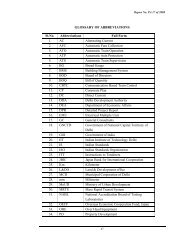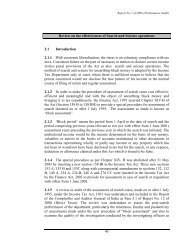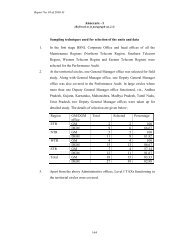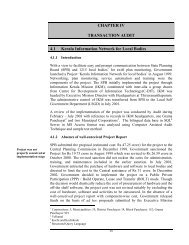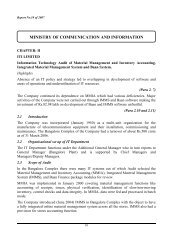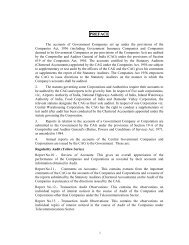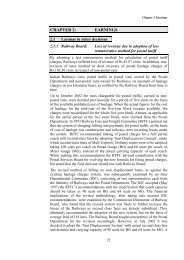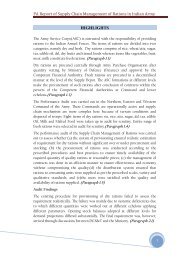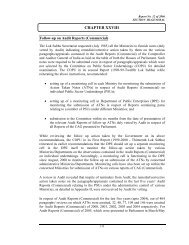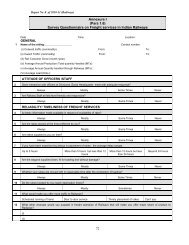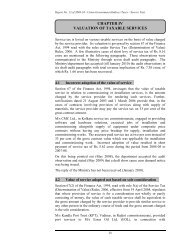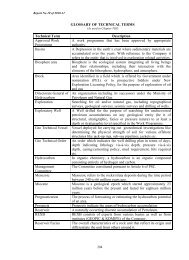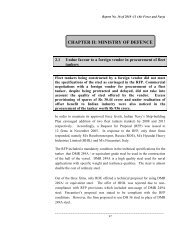Chapter 1 Freight services in Indian Railways - Comptroller and ...
Chapter 1 Freight services in Indian Railways - Comptroller and ...
Chapter 1 Freight services in Indian Railways - Comptroller and ...
Create successful ePaper yourself
Turn your PDF publications into a flip-book with our unique Google optimized e-Paper software.
<strong>Chapter</strong> 1 <strong>Freight</strong> Services <strong>in</strong> <strong>Indian</strong> <strong>Railways</strong><br />
concluded that the <strong>in</strong>frastructure was designed reckon<strong>in</strong>g the free time as n<strong>in</strong>e<br />
hours <strong>and</strong> therefore the reduction to seven hours was impracticable due to<br />
space <strong>and</strong> fund<strong>in</strong>g constra<strong>in</strong>ts. Unless IR <strong>in</strong>itiates concerted action with the<br />
M<strong>in</strong>istries of Coal <strong>and</strong> Power, detentions of roll<strong>in</strong>g stock beyond seven hours<br />
would cont<strong>in</strong>ue to occur.<br />
IR <strong>in</strong> its reply (March 2010) stated that the lower free time was prescribed to<br />
ensure faster release of wagons, which would correspond<strong>in</strong>gly lead to greater<br />
availability of wagons for load<strong>in</strong>g. However, s<strong>in</strong>ce the M<strong>in</strong>istries of Coal <strong>and</strong><br />
Power consider it impracticable with the current <strong>in</strong>frastructure, IR needs to<br />
<strong>in</strong>itiate concerted action with these M<strong>in</strong>istries on priority for ensur<strong>in</strong>g<br />
adherence to the prescribed free time allowance.<br />
Feedback of term<strong>in</strong>al/sid<strong>in</strong>g owners<br />
A majority of the 173 respondents to the survey of sid<strong>in</strong>g owners echoed<br />
similar sentiments as 52 per cent of them felt that mechanised<br />
load<strong>in</strong>g/unload<strong>in</strong>g facility was not available <strong>in</strong> term<strong>in</strong>als <strong>and</strong> that the free time<br />
allowed for load<strong>in</strong>g was <strong>in</strong>adequate. 50 per cent of the respondents however<br />
expressed satisfaction over the approach roads, light<strong>in</strong>g, stack<strong>in</strong>g area <strong>and</strong> the<br />
work<strong>in</strong>g hours at term<strong>in</strong>als. However, a significant 42 to 47 per cent of them<br />
felt that these facilities were <strong>in</strong>adequate.<br />
Thus even major freight term<strong>in</strong>als across IR that h<strong>and</strong>le more than 30 rakes<br />
every month were deficient <strong>in</strong> basic facilities. Modernisation of term<strong>in</strong>als by<br />
enhancement of facilities has not been fully implemented by the zones <strong>in</strong> most<br />
of the term<strong>in</strong>als lead<strong>in</strong>g to heavy term<strong>in</strong>al detentions of roll<strong>in</strong>g stock. The<br />
objective of reduc<strong>in</strong>g detentions due to load<strong>in</strong>g <strong>and</strong> unload<strong>in</strong>g operations<br />
below 16 hours has not been achieved. <strong>Freight</strong> Operations Information System<br />
<strong>in</strong> its present state was not serv<strong>in</strong>g as a decision mak<strong>in</strong>g tool.<br />
Recommendations<br />
IR needs to expeditiously provide the basic facilities <strong>in</strong> all freight term<strong>in</strong>als. IR<br />
should ensure that its <strong>in</strong>itiative of modernisation of freight term<strong>in</strong>als is<br />
effectively implemented <strong>in</strong> the zones to m<strong>in</strong>imise roll<strong>in</strong>g stock detentions at<br />
freight term<strong>in</strong>als.<br />
The system design <strong>and</strong> reliability of the <strong>Freight</strong> Operations Information<br />
System needs to be enhanced so that the IT application serves as a decision<br />
mak<strong>in</strong>g tool as envisaged.<br />
1.9.1.3 Capacity enhancement<br />
IR projected freight traffic of 1,100 million tonnes by the term<strong>in</strong>al year of the<br />
XI plan (2011-2012). To h<strong>and</strong>le the projected traffic volume, IR assessed that<br />
capacity augmentation <strong>and</strong> throughput enhancement works were essential <strong>and</strong><br />
identified capacity augmentation <strong>and</strong> throughput enhancement works. IR also<br />
identified works for improv<strong>in</strong>g the rail connectivity with ports. Upgradation of<br />
the permanent way was planned to cater to the enhanced load<strong>in</strong>g strategy.<br />
These works were over <strong>and</strong> above the works required to develop the Dedicated<br />
<strong>Freight</strong> Corridor. The overall annual outlay on capacity enhancement works<br />
ranged from Rs.4,365 crore <strong>in</strong> 2005-06 to Rs.8,650 crore <strong>in</strong> 2007-08.<br />
19


